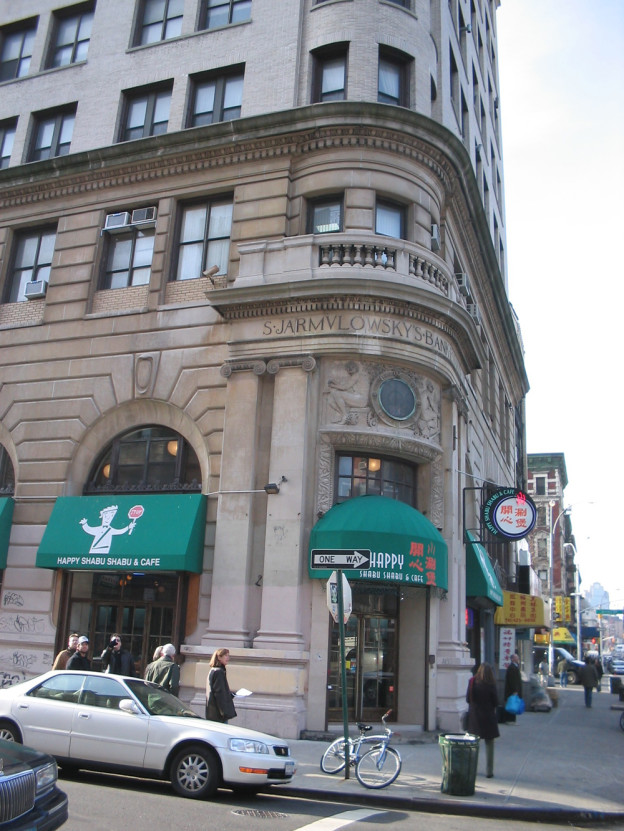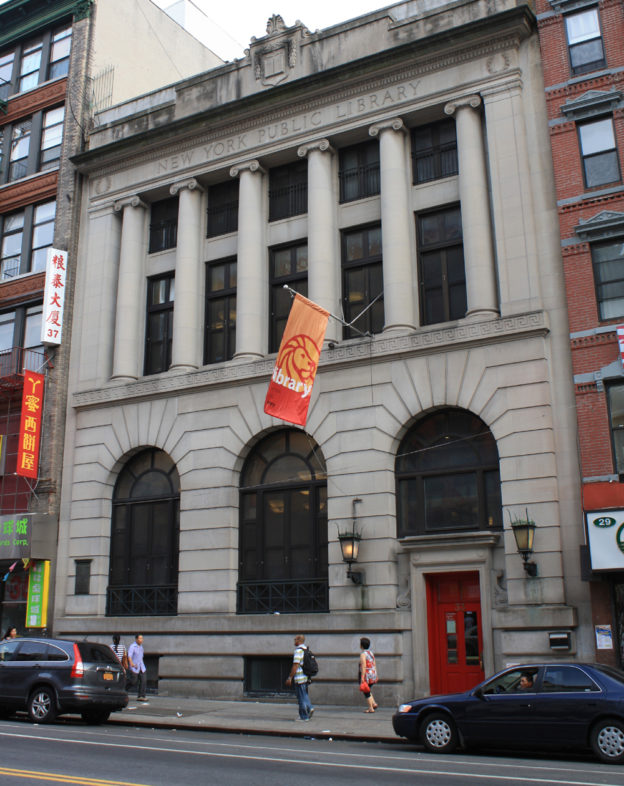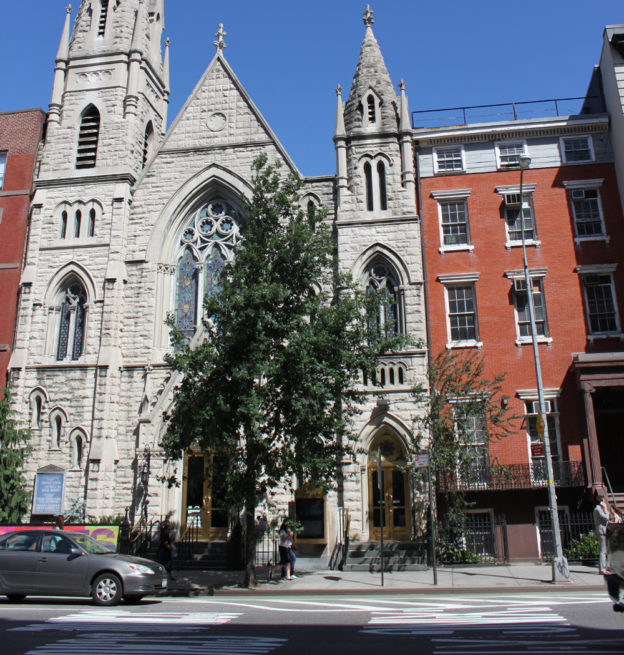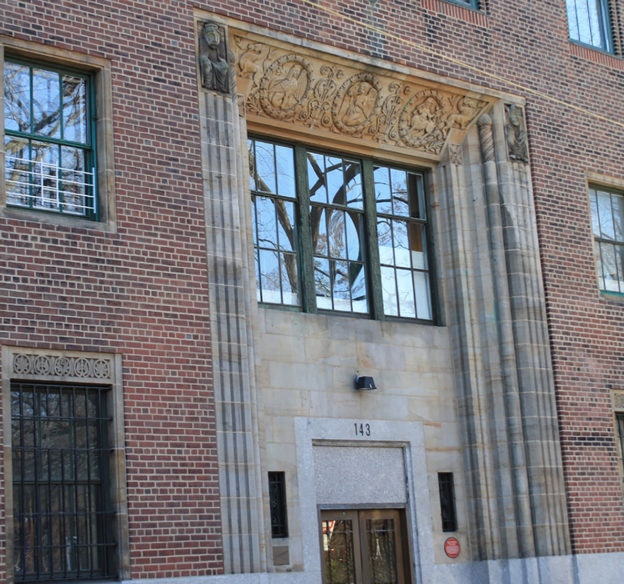54-58 Canal Street;
Rouse & Goldstone, 1912; redesign: William F. Coates, 1933|
Sender Jarmulowsky, an immigrant financier, established a bank in an existing building on this site in 1873, but replaced it with this 12-story Beaux-Arts tower in 1912. The building features a rusticated limestone base, terra cotta ornament and, until the 1990s, a domed temple-like cupola on top, which was a defining element of the Lower East Side skyline. The bank served neighborhood residents until it was forced to close in 1914 after being unable to meet patrons’ withdrawal demands at the outbreak of World War I. As federal insurance for banks did not exist yet, the economic burden of its closure fell on depositors, and a riot broke out in the street. The Former Jarmulowsky Bank is a designated New York City Individual Landmark.
97 Orchard, architect unknown, 1863-64;
14-16 and 47 Orchard Street, Herter Brothers, 1887|
Named for a grove of fruit trees on the DeLancey estate that comprised much of this area, Orchard Street is characterized by its tenements and history as a commercial thoroughfare, hosting many prosperous shops and street vendors. The five-story pre-law tenement at number 97 was purchased by the Lower East Side Tenement Museum in 1988 to interpret the history of immigration to the area. It is estimated that roughly 7,500 people from 25 countries resided in the building until it was sealed due to non-compliance with City housing codes in 1935. The six-story, red brick, Queen-Anne-style Old Law tenement at number 14-16 features a fanciful cornice and terra-cotta Stars of David, a feature shared by its sister building at number 47. 97 Orchard is listed on the State and National Register of Historic Places.
Tompkins Square Branch, 331 East 10th Street, McKim, Mead & White, 1904;
Rivington Branch, 61-63 Rivington Street, McKim, Mead & White, 1905;
Seward Park Branch, 192 East Broadway, Babb, Cook & Welch, 1909;
Chatham Square Branch, 33 East Broadway, McKim, Mead & White, 1903|
Businessman Andrew Carnegie funded the construction of 67 libraries in New York City between 1901 and 1929, and commissioned prominent architects to design them. Of the 57 still standing, four are located in the East Village and Lower East Side. Three of these were designed by McKim, Mead & White in the Classical Revival style: the Rivington, Chatham Square and Tompkins Square Branches. The Rivington Branch was the first library in the city to incorporate an open-air rooftop reading room, a feature that others soon copied. The Chatham Square and Tompkins Square Branches are grander, with arched window openings, columns and fanciful carvings. The Seward Park Branch was designed by the same architects responsible for Carnegie’s mansion on Fifth Avenue, and the two red brick and limestone, Renaissance Revival buildings bear a striking resemblance. The Tompkins Square Branch, Seward Park Branch, and Chatham Square Branch are all designated New York City Individual Landmarks. Tompkins Square Branch is located in the East Village/ Lower East Side Historic District.
Former Congregation Anshe Chesed, 172-176 Norfolk Street , Alexander Saeltzer, 1849-50 – NYCIL;
Former Congregation Rodeph Sholom, 8-10 Clinton Street, 1853;
Kehila Kedosha Janina Synagogue, 280 Broome Street, Sydney Daub, 1927-28 – NYCIL;
Former Eldridge Street Synagogue, 12 Eldridge Street, Herter Brothers, 1886-87 – NYCIL|
Anshe Chesed and Rodeph Sholom are respectively the oldest and second oldest surviving synagogue buildings in the city, and some of the oldest in the country. Both were constructed for German Jewish congregations in German architectural styles: Gothic Revival and Rundbogenstil (“round-arch style”), and feature red brick, central staircases and symmetrical façades with recessed central sections and square towers. Kehila Kedosha Janina Synagogue is the only Greek Synagogue in New York and the only synagogue of Romaniote Jews in the Western Hemisphere. The Eldridge Street Synagogue was America’s first major house of worship built by Eastern European Orthodox Jews. The yellow brick building features Moorish and Romanesque details and rich ornament. At its peak in the early 20th century, the synagogue hosted as many as 1,000 worshippers at services, but was forced to close in the mid-20th century when the area’s Jewish population began to dwindle. In 1986, the Eldridge Street Project funded a large-scale restoration of the building, which was repurposed as a museum. The Former Congregation Anshe Chesed,Kehila Kedosha Janina Synagogue and the Former Eldridge Street Synagogue are all designated New York City Individual Landmarks.
Interior of the block between East 2nd Street and East 3rd Street and Second Avenue and the ;Bowery est. 1831 – NYCIL & Nat’l Reg Property;
52-74 East 2nd Street, est. 1832 – NYCIL & NYCHD & Nat’l Reg Property|
New York Marble Cemetery and New York City Marble Cemetery were Manhattan’s first and second public, non-sectarian burial grounds. Respectively, they contain 156 and 256 underground vaults made of Tuckahoe Marble, hence their matching monikers. While marble tablets with vault numbers and owners’ names are affixed to the surrounding stone walls in both, only NYC Marble permitted markers and monuments above ground. The vaults belong to prominent politicians, merchants and members of some of the city’s oldest families. President James Monroe was interred in NYC Marble from his death in 1831 until being moved to Richmond, Virginia, in 1858. NY Marble’s last interment was in 1937, but NYC Marble’s vaults remain open to family members. Both cemeteries are open to the public on designated days (check their websites) and are visible through iron gates (NY Marble’s gate is located between 41 and 43 Second Avenue). Across the street from NYC Marble, note the limestone façade of Olivet Memorial Church, designed in the Gothic Revival style by J. C. Cady & Company in 1891. Both cemeteries are listed on the State and National Register of Historic Places and New York City Individual Landmarks. New York City Marble Cemetery is located within the East Village/Lower East Side Historic District.
107 Second Avenue, Ralph H. Segal, 1928;
72 Second Avenue, Landsman & Smith, 1928-29;
57 Second Avenue, George F. Pelham, 1903;
43 Second Avenue, Frederick Ebeling, 1907;
32 Second Avenue, Alfred Hopkins, 1917-19;
66 Second Avenue, David M. Oltarsh and H. Craig Severance, 1926-27;
66 East 4th Street c. 1832-33; altered: Kinkel & Klemt, 1871|
By the early 20th century, as the Lower East Side grew, Second Avenue became a bustling thoroughfare, its row house architecture either demolished or converted in favor of buildings hosting a mix of uses. Examples of its building types include: numbers 107 and 72, fanciful, terra-cotta-clad commercial buildings constructed in the late 1920’s; number 57, a nine-story New Law tenement that straddled the line between tenement and apartment building; number 43, the avenue’s first office building; and number 32, originally a City courthouse that was converted into the Anthology Film Archives in 1979. In the early 20th century, Second Avenue became known as the “Yiddish Rialto.” In addition to the Jaffe Theater, other significant sites include number 66, the Yiddish Public Theater that later served briefly as CBGB’s Second Avenue Theater, and 66 East 4th Street, the New York Turn Verein (German athletic and social club), where America’s first Yiddish-language theater performance is said to have taken place in 1882. Second Avenue between East 7th Street and East 2nd Street is located within the East Village/ Lower East Side Historic District.
112-114 Second Avenue,Samuel B. Reed, 1891-92;
110 Second Avenue, 1837-38;
323-327 East 6th Street 1847|
Middle Collegiate Church stands out both for its graceful 130-foot spire and for the uniform color and rich texture of its Indiana limestone, Gothic Revival façades. The red brick and brownstone, Greek Revival rowhouse next door was originally one of four built for wealthy merchant Ralph Mead. In 1874, it was purchased by the Women’s Prison Association, established in 1845 by Isaac Tatem Hopper and his daughter Abigail Hopper Gibbons, Quaker abolitionists and prison reform advocates. Still in operation, it is considered the world’s oldest halfway house for girls and women released from prison. Walk east on East 6th Street to the former St. Mark’s Evangelical Lutheran Church (converted to the Sixth Street Community Synagogue in 1940). One of the largest German churches in Kleindeutschland, a plaque commemorates the many congregants lost in the General Slocum steamboat disaster of 1904, the deadliest event in New York’s history before the attacks of September 11, 2001. Middle Collegiate Church is located in the East Village/Lower East Side Historic Ditrict. Women’s Prison Association / Isaac T. Hopper House is located in the East Village/Lower East Side Historic Ditrict, is a New York City Individual Landmark and listed on the National register of Historic Places. Former St. Mark’s Evangelical Lutheran Church is listed on the National register of Historic Places.
123-129 East 7th Street , Samuel Bessey and Thomas E. Tripler, 1861;
116-122 East 7th Street ,Joseph Ohmeis, 1862-63,;
Former First Hungarian Reformed Church, 121 East 7th Street c. 1843-45,; altered: Frederick Ebeling, 1903-04;
117 East 7th Street, Bernstein & Bernstein, 1907;
111 East 7th Street, Bernstein & Bernstein, 1901;
Saint Stanislaus Bishop and Martyr Roman Catholic Church, 107 East 7th Street (Arthur Arctander, 1899-1901;
95-97 East 7th Street Kurtzer & Rohl, 1891;
97½-99 East 7th Street Schneider & Herter, 1891|
This block is part of the East Village / Lower East Side Historic District, and contains examples of pre-law, Old Law and New Law tenements in different styles. Numbers 116-122 and 123-129, two sets of four pre-law tenements on either side of the street, were built by developers on land leased by the Astor family. Number 122 has a well-preserved storefront, with wood-frame show windows and cast-iron piers and columns. Number 121 offers a striking example of a converted rowhouse, which was transformed into the First Hungarian Reformed Church in 1903-04. The church retained the house’s fenestration, but added a stone façade with arched openings and a belfry-like dormer at the roofline. Next door, numbers 117 and 111 are two New Law tenements designed in the Renaissance Revival style. Up the block, past the ornate Saint Stanislaus Bishop and Martyr Roman Catholic Church, which was the center of the Lower East Side Polish Roman Catholic community until the mid 20th century, numbers 95-97 and 97½-99 are Old Law tenements built in the Queen Anne style. East 7th Street between Avenue A and First Avenue is located in the East Village/Lower East SIde Historic District, which was deginated in 2012
East 7th Street to East 10th Street, Avenue A to Avenue B;
1834|
Named for Daniel D. Tompkins, Governor of New York (1807-17) and Vice President under James Monroe (1817-25), this park has a long history as a political gathering place. In 1857, immigrants protested unemployment and food shortages. In 1863, it hosted deadly Draft Riots prompted by the outbreak of the Civil War. In 1874, thousands of workers protested unfair conditions in the Tompkins Square Riot. In 1877, the National Guard sparred with 5,000 gatherers for Communist revolutionary speeches. More recently, the park was host to protests against the Vietnam War and for women’s rights in the 1960’s. By the 1980’s, the park had become an epicenter of crime and illegal drug use. In August 1988, after police attempted to clear the park of homeless encampments, a riot broke out and 44 were injured. In 1991, the police department evicted the park’s roughly 150 residents in an early morning raid and closed down the park. As the area has gentrified, this peaceful nook, with its glorious elm trees, recreation facilities and diverse array of festivals, seems a far cry from its tense past.
East 10th Street between Avenue A and Avenue B;
143 Avenue B, Henry C. Pelton, 1928|
The 26 buildings on the north side of Tompkins Square Park comprise the East 10th Street Historic District. The City opened the park in 1834 to stimulate development in the area, but the Panic of 1837 delayed construction around the square until the late 1840’s. Though some were modernized in the late 19th and early 20th centuries, these rowhouses were some of the city’s first to employ the Italianate style. Later, as the population swelled, tenements were constructed on some of the lots and rowhouses were converted into multi-family dwellings. Newer buildings include the Old Law tenements at numbers 321 and 323 and the Tompkins Square Branch of the New York Public Library. On the east side of Tompkins Square is Christodora House, an Art Deco settlement house converted into condominiums in 1986, sparking one of the East Village’s first anti-gentrification protests, in which participants chanted the famous line: “Die, yuppie scum!”
The Christodora House is a listed on the State and National Register of Historic places. 143 Avenue B is listed on the State and National Register of Historic Places.










